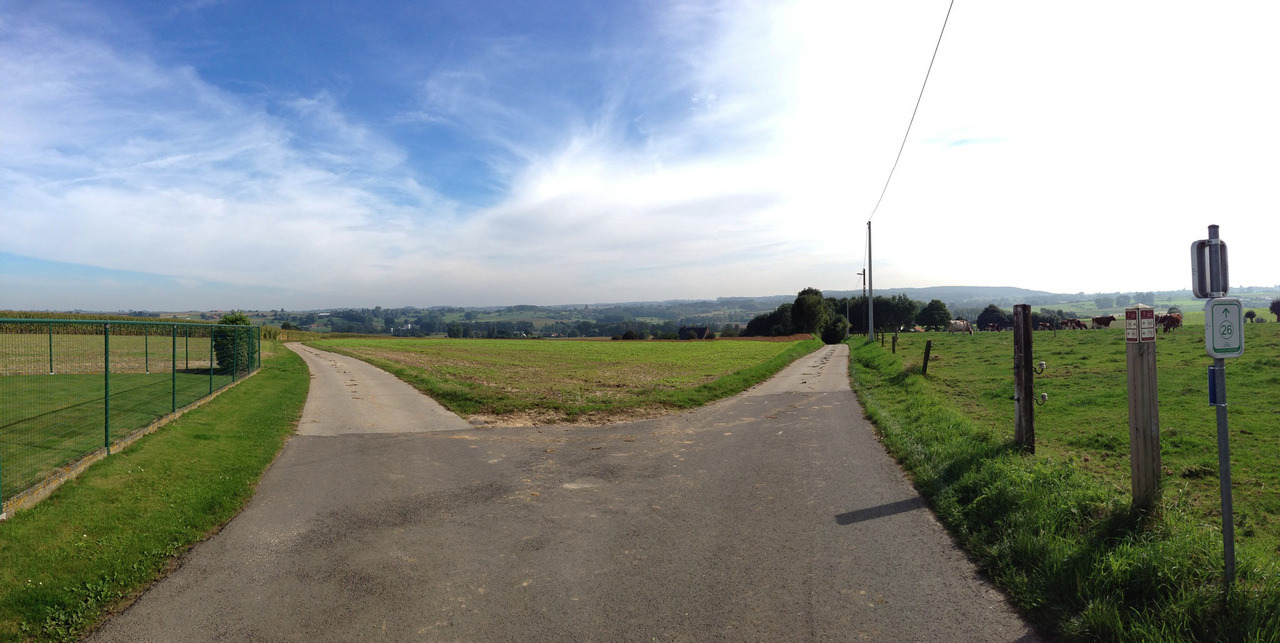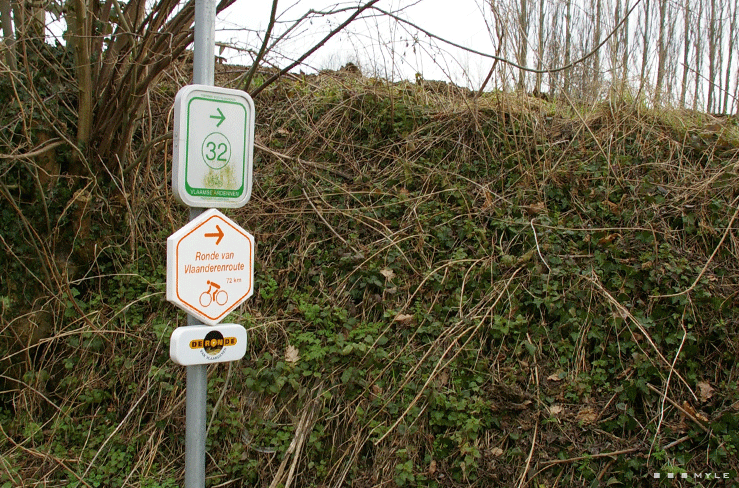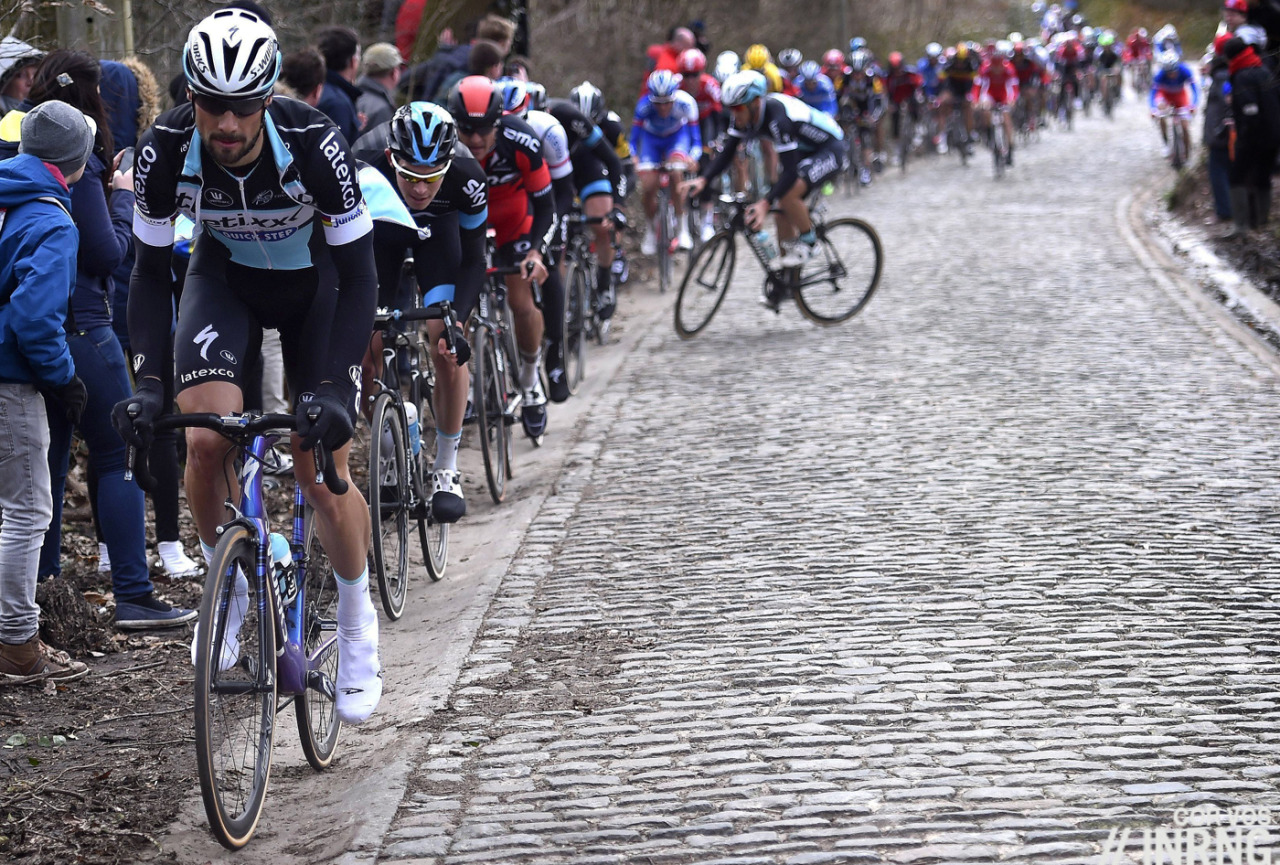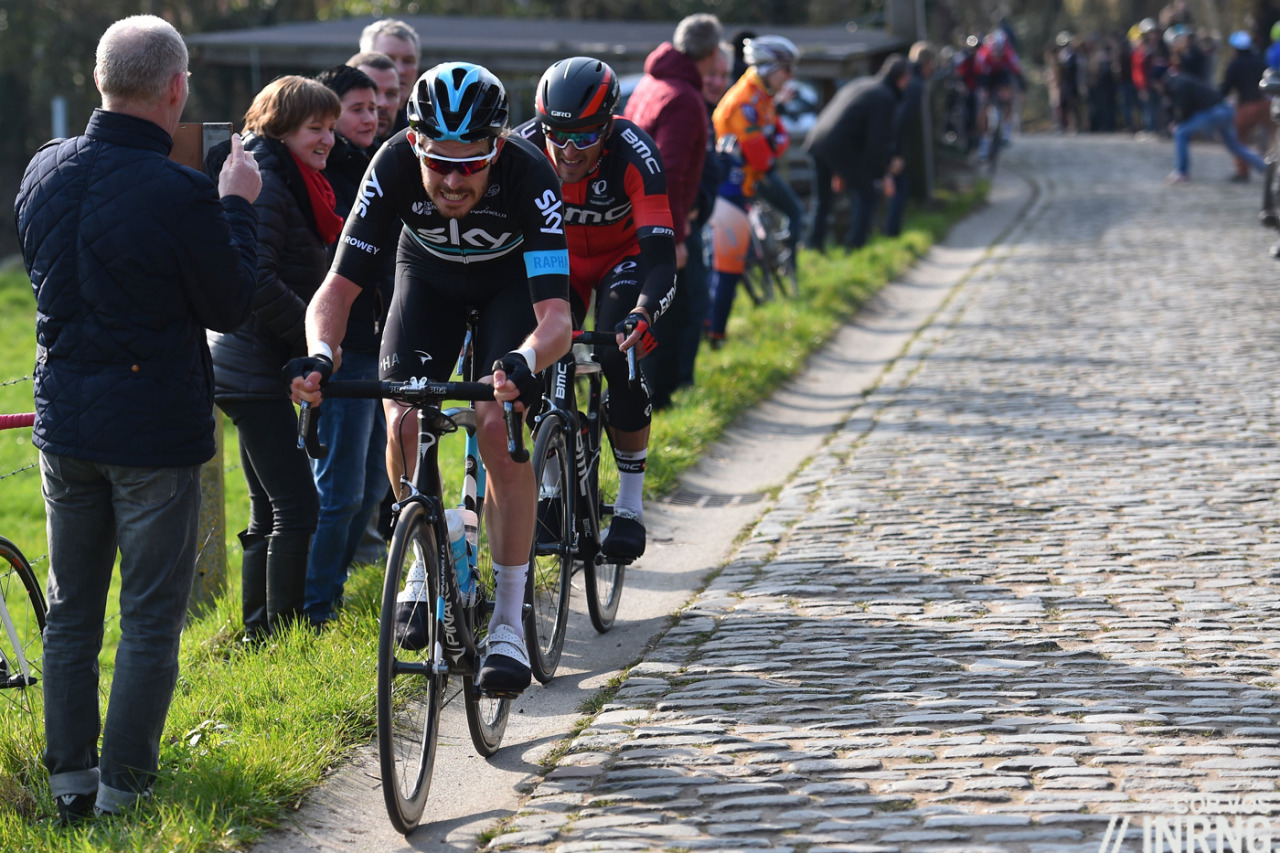A fixture in the Flemish classics, the Taaienberg is a cobbled climb where it’s all about the gutter, the thin strip of concrete that makes this tough berg into the perfect place to blow the kopgroep apart.
The Route: the Taaienberg is just south of the town of Maarkedal in East Flanders, Belgium. It is 630m long and climbs at an average of 6.8% with a maximum of 16%.

The Feel: like many of the hellingen, the small hills in Flanders, you’ve got to keep your eyes open. The road network often isn’t the usual crossroads and t-junctions, at times it’s more organic, like a system of arteries and capillaries with lanes bending away from the road. Do you turn here or carry on? Do you carry on or turn there? It’s like one of those choose-your-own-adventure novels.
There are maps and signs – more of which below – and a GPS device on your bars can route you straight there, just be sure to take in the landscape rather than stare at the screen. You need to look up to see the ridge of land ahead, it only sits 50 metres above you. On the approach there’s a block of grain silos, a visual cue and once you reach the spot there’s no mistaking the road: A small sign says it’s the Taaienberg. The betonweg rises up in approach to the cobbles with a straight transition from the concrete to the cobbles just where a tunnel of woodland canopy shrouds the road, as if some landscape gardener designed it just so.
Do you go for the gutter? There’s the risk of debris causing a puncture but the pavé are hardly brushed clean either so it’s the side: it’s what this climb is all about. If you want to take the cobbles they’re not savage but certainly slower. Instead it’s the gradient that bites, the road rears up to 12-14% and stays this way for 250 metres which doesn’t sound long but unless you attack the slope it takes time. Ride the gutter and you’re focussed on the road just metres ahead as you try to stay in the smooth channel but avoid stones, sticks and other debris. When slope eases the view opens up with there’s a field on your right, on a normal day you can enjoy the views to the south in between the farm buildings. Soon the climb is over and the usual route is to turn left at the junction only here the road keeps climbing, gently but you can see how hard this is in a race because the effort goes on and on, riders who have established a gap have to press on while those behind hesitate to chase.
The Verdict: a textbook Flemish berg with the betonweg approach, the cobbles and then the classic “wall” profile of a double-digit gradient. In isolation it’s nothing special, it’s not the steepest, the longest nor the most famous but it is selective and one to observe closely if you watch the Tour of Flanders on TV.

Ride more: you’re unlikely to come for the Taaienberg alone. To visit is to realise just how compact this area is, you can do many of the famous climbs in a short ride and pack in the lesser known descents and hills. The Koppenberg, Kanarieberg, Kruisberg and Kaperij are just a short spin away… and that’s just the ones beginning with K. One problem is finding the routes, not that they’re a mystery, it’s the opposite with layers of regional, local and municipal tourist and transport bodies all offering websites, leaflets, maps. It’s great but you can lose yourself amid the piles of paper and web pages on offer. Out on the road many routes are sign posted but not every junction. The cyclinginflanders.cc website is an excellent website, it’s in English, has route suggestions and even downloadable route maps for GPS bike computers.

The History: it was first included in the Tour of Flanders in 1974 and has been used ever since except for 1993 when roadworks put it out of action, it was then that fresh pavé was laid. It got nicknamed the Boonenberg for the way Tom Boonen would attack almost every time on this slope. Why? Because it was a good test, a sprint to get into position ahead of the climb and then a 90 second effort up and over before surveying the damage.

The Gutter: who’d have thought a drain was of such strategic importance? Only the flat concrete laid to drain water is so much smoother and faster than the pavé that it’s space worth fighting for. Both sides have a gutter but the left side collects more dirt and stops further up making the right the default choice. This effectively shrinks the three metre wide road down to the width of your bars and so the first rider in the race can dance up at their own pace while behind everyone has to follow. If one rider in the line slows, either because they can’t sustain the pace or because they’re blocking for a team mate ahead then everyone has to venture on to the cobbles to pass them, no easy feat. This way it is easy to create a gap with a direct effort and so there’s a fierce sprint into the climb. In 2012 Lars Boom tangled with Tom Boonen and wiped out, it might sound comic but Boom’s not exactly a lightweight prone to wobbling on his bike it shows the ferocity of the approach. Some might say the gutter should be closed off with barriers but that would be to deny the point of this climb and to make this climb more egalitarian and less selective. Only come the Tour of Flanders that’s exactly what they do and the gutter has been off-limits to the riders.

The name: literally the “tough hill” but the etymology of word suggests something that is hard going, like chewing a bad steak.
Travel and Access: it sits inside the golden triangle of transport between Brussels, Lille (France) and Amsterdam (Netherlands) with a range of air, high speed rail and road networks. Closer to the ground Oudenaarde is a good base for hardcore cyclists while Gent is better if you’re coming with family or friends, mixing plenty of cycling themes in a lively and prosperous student town.
- Photo credits: top image and fork in the road via Flickr’s Koppenbadger ; Flanders route signs by Flickr’s Mister Myle
More roads to ride at inrng.com/roads



The tension Is building. Looking forward to riding the parcours Saturday. But roll on Sunday. I’m going for a French influenced podium. But it would be rude to suggest any predictions here. Watched the 2011 Edition last night. Good Times
I’ve never been there, but I would presume that this is a berg where to even contemplate dropping into the inner ring is to invite the wrath of the Cycling Gods?
Cross-chain or bust.
Sacrifice your lovely new Dura Ace if you must.
Just don’t drop into the Inner Ring.
🙂
Some do use the big ring in the race but plenty don’t. Didn’t Tom Boonen have gear problems last year in the Ronde, he was approaching “his” climb and jammed the chain. So if the inner ring is good enough for him on the Taaienberg, I’d recommend it to others too 😉
Jonge jonge jonge 🙂
He did, I can see the corner in my minds eye. Bit of a sweeper before it starts to ramp up steadily. Ridden it on the Saturday with many others and quietly during the week when no ones around. It had a welcoming feeling that you find with some climbs. Do you think the smaller 7 man teams will have a huge effect on today’s DDV?
For people who are planning to ride the “hellingen” in Flanders someday.
In Oudenearde there is een Museum/Coffeeshop/exhibition centre. Called ” Centrum ronde van Vlaanderen” . A good starting and finishing point for your ride. near the big square with lots of bars etc.
http://crvv.be/?lang=en
I once rode a 100km version of the ” ronde” me first and last time i did cobbles. I was afraid my old bike would break and really hated those cobbles. I prefer to ride with wind in the back on a sunny day on new flat tarmac.
Until you’ve done the Trouée d’Arenberg you haven’t done cobbles.
There are many sectors of pave, and some have the most monstrous cobbles, it’s like riding a million speed bumps, but the Arenberg takes the biscuit because it’s damp and muddy. Riding that was the equivalent to the first five minutes of Saving Private Ryan. It was bicycle carnage – riders down all over the place. A penny farthing and an ambulance for good measure, all the while viewed in that juddering distortion that only cobbles or a top grade film director can give you. Terrifying.
Must admit that I long to try the Paterberg and the Kwaremont. Should be epic this weekend. I note that Sagan has given Dwaar the elbow flick – I felt he did this metaphorically to E3 on Friday so he could mop up at Gent-Wevelghem, and he surely did. I expect the same on Sunday.
Agreed. Cobbles in Flanders are far different than cobbles on the Paris-Roubaix route. At P-R it’s hard enough to WALK over them! Reminds of back-in-the-day a couple of clients came a week early for the TdF tour we were running. As they assembled their bikes at a hotel not-too-far from the famous cobbles I asked what they’d planned to do until the TdF tour started? “Oh, we’re going to spend a week riding the cobbles of Paris-Roubaix!” was the reply. My advice was to make sure there were other activities as after a few hundred meters on those stones, they would be looking for a “Plan B”. They laughed…but one week later admitted I was right and that they’d bailed on the idea after their first cobbled sector.
Very interested to see how Nibali goes on Sunday. One would think he’s got some form left post MSR, but will be be content to JRA his first time?
This is bang on.
I rode both the Ronde and the Paris Roubaix sportif in 2015. Loved every minute of both…except for Trouée d’Arenberg, which completely defies description. Although RQS has made a good fist of it! I often wonder if it feels less slippery and sketchy if ridden at high pace, as the pros do it.
The secret is that they clean the cobbles before the pros get on there, which sort of feels like they are cheating, but I suspect that the Sportive riders bring a ‘wash’ of dirt and water over these which might otherwise not be there.
Certainly makes them horrendously dangerous. I certainly sweated my way over, though they were the first pavé sector I rode on. A trial by fire for sure. I wasn’t looking forward to the remaining dozen or so sectors to come if they were all like that.
The only way to do them is sprint (or go all out at least) – which on the 3km bits is verging on the impossible. If the effort doesn’t get you the vibrations will!
The Taaienberg is certainly one of my favourites, just for the quietness and unassuming build up. When you get to the top and you’re just on a road in a sleepy Flandrian village it’s a nice contrast from watching Boonen blast up it on TV.
5 years ago I did a short five day bike tour of Belgium on a 1980s Peugeout. Brussels to Lille in a day is a good route as you can blast around the bergs during the day (I think I did the Muur, Taaienberg, Kopppenberg, Paterberg, Kanaerieberg that day), then end in a spin at the velodrome in Roubaix (North East Lille).
This was in mid July as well – nice to see the bergs without the Tour of Flanders decorations.